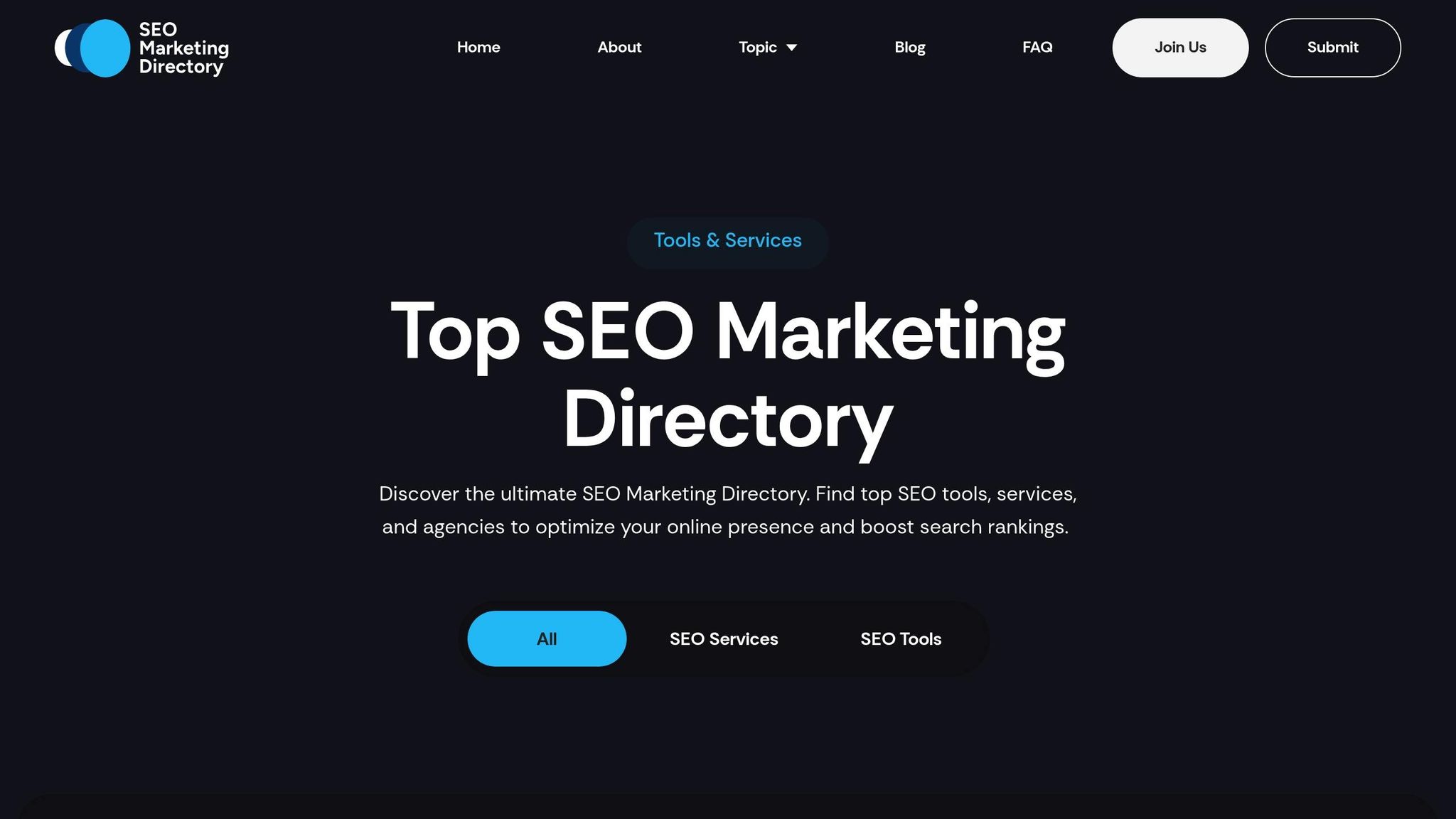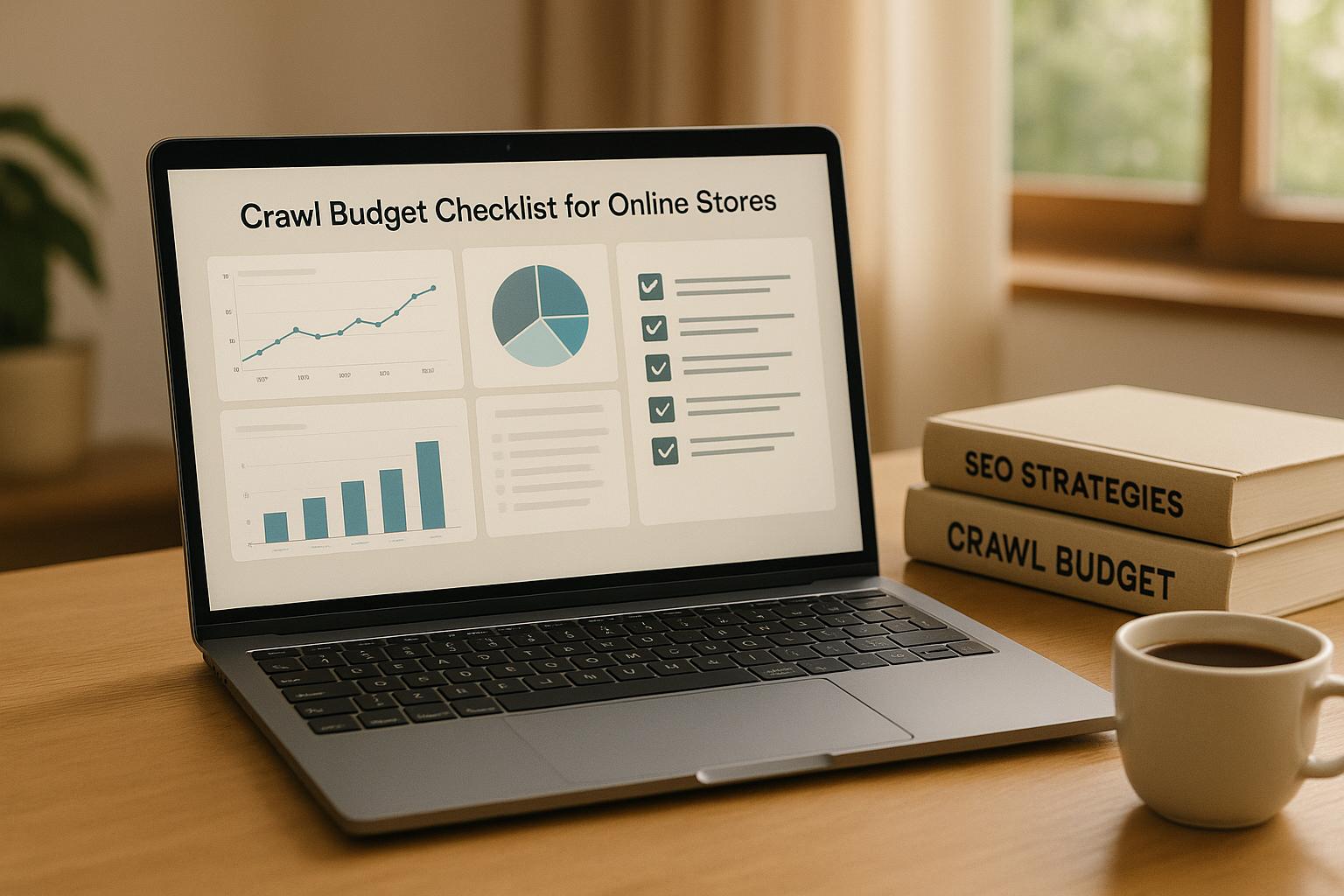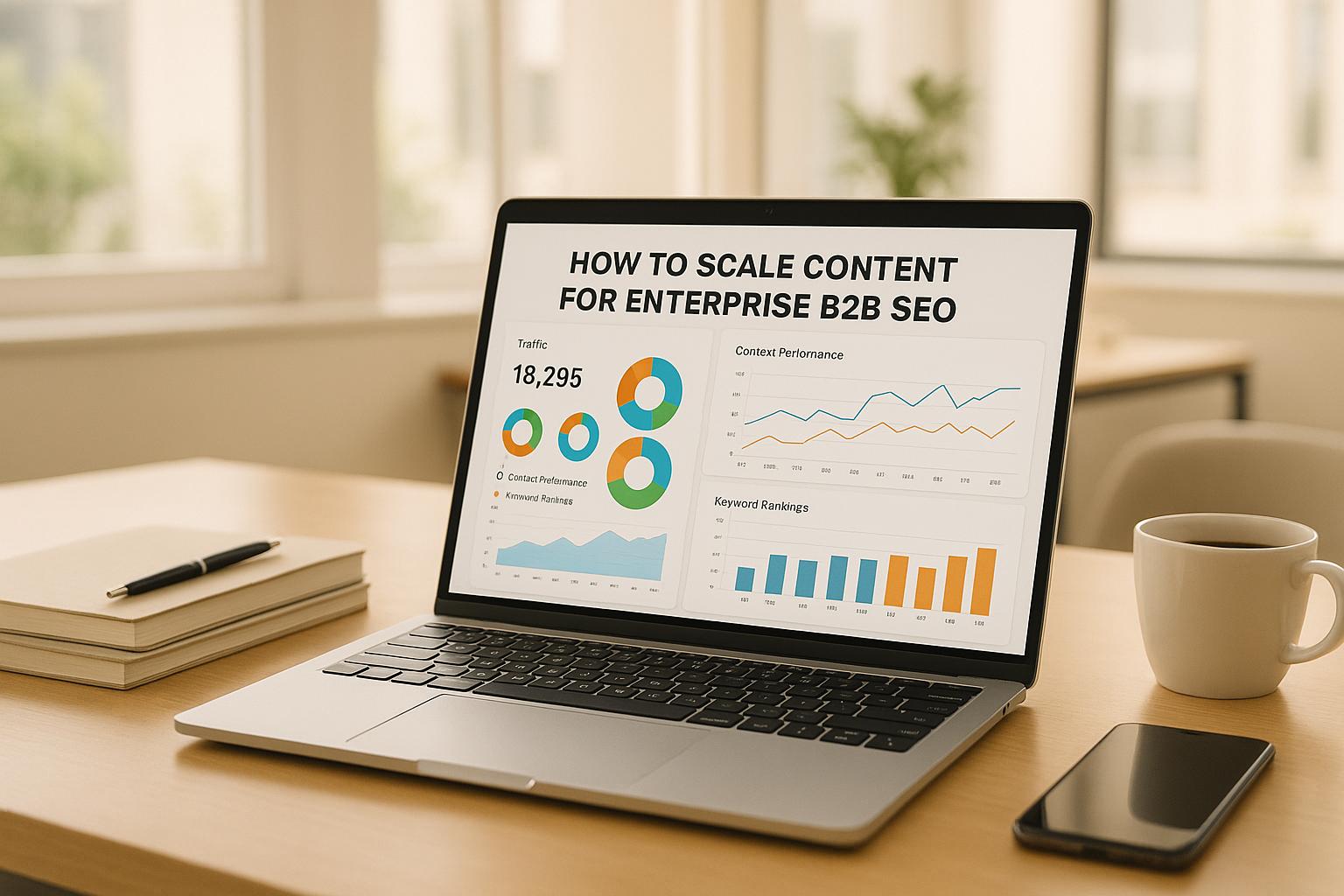User intent mismatches happen when your content doesn’t align with what searchers are looking for. This hurts your rankings, traffic, and conversions. Fixing this involves understanding user intent (informational, navigational, transactional, or commercial investigation), identifying mismatches, and making targeted adjustments to your content and technical SEO.
Here’s how to quickly address the issue:
- Understand the 4 types of user intent: Informational (e.g., “how to”), Navigational (e.g., “Facebook login”), Transactional (e.g., “buy iPhone 15”), and Commercial Investigation (e.g., “best laptops 2025”).
- Spot mismatches: Use metrics like high bounce rates, low click-through rates, and user behavior data to identify where your content isn’t meeting expectations.
- Fix issues: Update content to match intent, resolve keyword cannibalization, and address technical problems like duplicate content, slow load times, or poor mobile performance.
The goal is to create content that satisfies user needs while improving SEO performance. Start by auditing your site, refining your content strategy, and leveraging tools like Google Search Console to monitor results.
What is User Intent and Its 4 Main Types
User Intent Definition
User intent refers to the main goal behind every search query. It’s what someone hopes to achieve when they type something into a search engine. Think of it as understanding the "why" behind the search, not just the "what."
For example, if someone searches for "iPhone 15 battery life", they might be comparing its performance, troubleshooting a problem, or looking for ways to make the battery last longer. Pinpointing this underlying purpose is what separates successful SEO strategies from simple keyword stuffing.
To truly connect with your audience, your content needs to go beyond just including the right keywords - it must address the real need behind the search. Let’s explore the four main types of user intent that shape search behavior.
4 Types of Search Intent
Search intent can be grouped into four main categories, each requiring a unique content strategy:
- Informational Intent: This is when users are seeking knowledge or answers. These queries often begin with words like "how", "what", "why", or "when." Examples include "how to change a tire" or "what is cryptocurrency." At this stage, users are simply gathering information - they’re not ready to buy anything yet.
- Navigational Intent: Here, users are looking for a specific website or page. They know where they want to go but use a search engine to get there quickly. Searches like "Facebook login", "Amazon customer service", or "Nike official website" fall into this category.
- Transactional Intent: These searches indicate users are ready to take action, whether it’s making a purchase, downloading something, or subscribing. Queries like "buy iPhone 15 Pro Max" or "download Photoshop trial" show clear intent to act.
- Commercial Investigation Intent: This type blends informational and transactional intent. Users are researching products or services they’re planning to buy soon. They might compare options, read reviews, or hunt for deals. Examples include "best laptops 2025", "iPhone vs Samsung comparison", or "top SEO tools review."
Understanding these categories is key to creating content that aligns with user needs and boosts your SEO performance.
Why User Intent Matching Matters for SEO
Matching your content to user intent is critical for improving search rankings and achieving business goals. Search engines prioritize content that fulfills user intent, which means your pages are more likely to rank higher if they meet searchers’ needs.
When your content delivers exactly what users want, it creates a positive cycle. Visitors stay on your site longer, interact with your content, and are less likely to hit the back button. These actions signal to search engines that your content is relevant and valuable.
The benefits go beyond rankings. Aligned content leads to higher engagement, longer time spent on your site, and lower bounce rates. Plus, users who find what they’re looking for are more likely to take the next step - whether that’s making a purchase, signing up for your newsletter, or contacting your business.
Tailoring content to user intent also allows you to address different stages of the customer journey. For example, informational content attracts users in the early awareness stage, while transactional content appeals to those ready to buy. This approach helps you create a well-rounded content strategy that supports users at every step of their decision-making process.
Most importantly, aligning with user intent improves the overall user experience. When people find exactly what they need on your site, they don’t have to keep searching. This builds trust and encourages repeat visits. Over time, delivering consistent, relevant content can turn casual visitors into loyal advocates for your brand.
User Intent - the one thing you can't miss in SEO
Why User Intent Mismatches Happen
Figuring out why your content misses the mark when it comes to user intent is crucial for fixing SEO missteps. Most of these mismatches trace back to three main problems, which can trip up even experienced SEO professionals. Let’s dive into these issues, starting with keyword targeting mistakes.
Wrong Keyword Targeting
One of the biggest culprits behind intent mismatches is targeting keywords without fully understanding what users are looking for. Many content creators get caught up in metrics like search volume and competition, overlooking the actual purpose behind the search.
Take the keyword "apple" as an example. A tech blog might write about Apple Inc.'s products, but users searching for "apple" could be after fruit nutrition facts, recipes, or even stock prices. Ignoring this variety in user intent leads to poorly targeted content.
Another common misstep is mixing different intent types on one page. For instance, trying to rank a single page for both "how to choose running shoes" (informational intent) and "buy Nike running shoes online" (transactional intent) creates confusion. Neither users nor search engines can figure out what the page is supposed to accomplish.
Seasonal keywords also need careful handling. A term like "Christmas lights" might attract informational searches in October but shift to buying intent in December. Failing to adapt to these changes results in mismatched content.
Misreading User Needs
Even if you pick the right keywords, misinterpreting user needs can lead to off-target content. This happens when creators rely on assumptions rather than digging into actual search behavior.
For example, someone searching for "best project management software" likely wants a detailed pros and cons list, while "Asana vs Monday.com" calls for a side-by-side comparison. Offering generic "best of" content for comparison queries leaves users unsatisfied.
Local searches, like "pizza delivery", demand specific details such as service areas, local contact information, and delivery times. A generic page won’t meet these needs.
Time-sensitive searches are another area where intent gets misread. A query like "tax deadline 2025" requires up-to-date, specific information about that year’s filing requirements. Evergreen content about general tax deadlines won’t address the urgency of the search.
Technical Problems and Keyword Conflicts
Technical issues can also derail your content’s ability to match user intent. One major problem is keyword cannibalization, where multiple pages compete for the same keywords but serve different intents.
For instance, if you have separate pages targeting "email marketing tips", "email marketing software", and "email marketing services", search engines might struggle to determine which page to rank for a specific query. This confusion often results in the wrong page showing up for users.
Other technical issues - like broken internal links, slow page load times, or poor mobile responsiveness - can disrupt the user journey, preventing your content from meeting their needs.
Duplicate content is another headache. If the same product description appears on your main product page, category page, and a blog post, search engines might rank the blog post for transactional searches instead of directing users to the product page where purchases can actually be made.
When these technical problems stack up, they create a ripple effect that damages both user experience and search rankings. Fixing these issues is key to aligning your content with user intent and boosting your SEO results.
How to Find User Intent Mismatches
Understanding where your content fails to meet user intent is a critical part of improving SEO performance. If your content doesn't align with what users are searching for, it can lead to missed opportunities and lower engagement. Here's how you can identify those mismatches by analyzing user behavior, conducting technical audits, and reviewing search query data.
Check User Behavior Data
User behavior metrics offer valuable insights into whether your content meets expectations. Some key metrics to watch include:
- High bounce rates and short session durations: If users leave your page quickly (e.g., bounce rates over 70% or session durations under 30 seconds), it's a strong sign that your content doesn't match their needs. This often happens when users realize the page isn't delivering what they were searching for.
- Click-through rates (CTR): If a page ranks in the top 5 positions but has a CTR below 5%, it could mean your title or meta description is attracting the wrong audience. Pairing low CTR with poor on-page engagement further confirms a mismatch.
- Heatmaps: Tools like heat mapping reveal where users focus their attention on your page and where they lose interest. For instance, if users scroll extensively but don't engage, your content may be mixing informational and transactional signals, leaving visitors confused.
Additionally, look at conversion funnel data to identify where users drop off. This can highlight missed opportunities to align your content with their intent.
Run Technical SEO Audits
Technical issues can also create mismatches between your content and user intent. A thorough SEO audit can help uncover structural problems such as:
- Keyword cannibalization: If multiple pages target the same keyword, search engines may struggle to determine which page should rank. Use tools like your search console to identify competing pages.
- Internal linking issues: Ensure your internal links use anchor text that matches the linked page's purpose. Misaligned anchor text can confuse both users and search engines about a page's intent.
- Duplicate content: Content duplication across pages (e.g., identical product descriptions appearing on category pages, product pages, and blog posts) can dilute the clarity of your intent. This is especially problematic for transactional searches.
- Site speed and mobile responsiveness: Users with transactional or commercial intent are less likely to tolerate slow-loading pages. While informational searchers might have more patience, ensuring fast load times and mobile-friendly designs is essential for better intent alignment.
Technical audits help ensure your site's structure supports clear and accurate intent matching.
Analyze Search Query Reports
Search query reports from tools like Google Search Console provide a deeper look into how users find your pages and whether your content aligns with their expectations. Here's what to focus on:
- Queries with low clicks: If your page ranks for certain terms but gets few clicks, it likely doesn't match what users are looking for. For example, if "project management software pricing" leads users to a general comparison page, the content isn't meeting specific transactional intent.
- Impression-to-click ratios: Pages that appear for many queries but generate few clicks might be targeting keywords with mixed intent or failing to clearly communicate their purpose in search results.
- Long-tail keywords: Specific queries, like "how to export data from Salesforce to Excel", highlight unique user needs. If users land on a general Salesforce integration page instead of a detailed guide, you're missing a chance to meet their informational intent.
- Seasonal shifts in intent: Some keywords change intent based on the time of year. For example, "tax software" may attract informational searches early in the year but shift to transactional intent closer to tax deadlines. Regular updates to your content can help address these shifts.
- Device and location filters: Mobile and desktop users often have different intents, even for the same keyword. Similarly, local modifiers in search queries indicate geographic intent that generic content might not satisfy.
sbb-itb-5be333f
How to Fix User Intent Mismatches
Once you've identified intent mismatches, the next step is to take targeted actions to realign your pages. This involves updating content, addressing keyword issues, and resolving technical problems to ensure your site meets user expectations.
Update Your Content
The easiest way to bridge intent gaps is often by refining your content. Start by tailoring your pages to match the specific intent behind your target keywords. For instance, if your page blends informational and transactional elements, consider separating them to better serve user needs.
- For informational intent, prioritize providing clear, helpful answers. Turn pages overloaded with product details into in-depth guides that address user questions first. For example, if someone searches for "how to choose project management software" but lands on a product comparison page, restructure it to include tips on selection criteria, implementation advice, and common mistakes before showcasing specific tools.
- For transactional intent, focus on simplifying the buying process. Skip long-winded explanations and instead highlight product features, pricing, and direct calls to action. A page targeting "buy accounting software" should make it easy for users to evaluate options and make a purchase, rather than diving into general accounting advice.
- For commercial investigation, users need detailed comparisons and reviews. Include side-by-side feature breakdowns, pros and cons, and real user testimonials. This approach works well for searches like "best email marketing tools" or "Salesforce vs HubSpot", where users are weighing their options.
Also, keep the search context in mind. Mobile users often have different needs than desktop users. By creating mobile-optimized pages with quick answers and easy navigation, you can better serve users searching on their phones.
Lastly, reduce keyword overlap to further refine your content strategy.
Fix Keyword Cannibalization
Keyword cannibalization happens when multiple pages on your site compete for the same search terms, leaving search engines unsure about which page to rank. This often results in the wrong page being displayed for user queries.
To address this, use tools like Google Search Console to identify competing pages. For example, if both a blog post on "email marketing best practices" and a service page for "email marketing services" rank for the same keywords, you likely have a cannibalization issue.
Here’s how to fix it:
- Merge or consolidate content if two pages serve the same purpose. A single, comprehensive resource can often perform better than scattered content.
- Differentiate pages if they cater to different intents. For instance, your blog post might target "how to create effective email campaigns", while the service page focuses on "professional email marketing services."
- Update internal links to guide users and search engines to the correct page. Use descriptive anchor text to clarify the intent of each page.
After making these adjustments, monitor your results over 4–6 weeks. If rankings improve and users land on the right pages, your fixes are working. If problems persist, you may need further refinements or technical tweaks.
Solve Technical SEO Problems
Even the best content can fail if technical issues get in the way. Technical SEO problems often prevent pages from gaining visibility, so resolving these is critical to aligning user intent.
- Optimize mobile performance. With mobile devices accounting for over 62% of global web traffic, your pages need to load quickly and display properly on smaller screens.
- Address duplicate content. Use canonical tags to signal the preferred version of a page or rewrite duplicate material to serve distinct purposes.
- Fix indexing issues. Check your search console for crawl errors or blocked resources. If search engines can’t index your pages, they won’t rank for their intended keywords - even if the content is excellent.
- Organize your site architecture. Group content into clear categories that reflect different user intents. For example, use URL structures like "/guides/" for informational content and "/products/" for transactional pages to improve clarity for both users and search engines.
- Speed up page loading times. Slow pages can frustrate users, particularly on transactional pages where quick performance is expected.
Regular technical audits are essential to maintaining a strong foundation for intent alignment. Google's March 2024 update highlighted the importance of pairing high-quality content with solid technical setups. Addressing these issues ensures your intent-optimized pages can perform as they should.
Using Top SEO Marketing Directory for Intent Solutions

Once you've tackled content and technical fixes, specialized tools can make intent optimization much easier. The Top SEO Marketing Directory is a curated resource offering tools designed to align your content with user intent effectively.
Directory Overview
The Top SEO Marketing Directory organizes SEO tools into categories that directly address challenges related to intent alignment. For example, it includes keyword research tools that analyze keyword intent, helping you understand users' goals. It also features content optimization platforms that provide SERP analysis, enabling you to determine whether search results indicate commercial intent (users shopping for products or services) or informational intent (users seeking answers or guides).
For technical SEO, the directory highlights tools that diagnose issues like crawling errors, architecture flaws, and mobile usability problems - factors that can prevent your site from reaching users with the right intent. Additionally, the analytics and reporting tools section includes platforms that track key user behavior metrics, such as bounce rates and session duration, which are critical for assessing how well your content aligns with user intent.
For businesses focused on local customers, the directory’s local SEO tools are especially useful. These tools are tailored to optimize location-based queries, which often combine commercial and navigational intent. For instance, when map packs appear in search results, it signals strong local intent, and these tools can help businesses capitalize on those opportunities.
These tools complement earlier strategies by offering real-time insights and actionable data, providing a deeper understanding of user intent.
Benefits for U.S. Businesses
American businesses gain unique advantages from the directory, as it focuses on tools that cater to the U.S. market. Pricing is displayed in U.S. dollars, simplifying cost comparisons and budgeting for intent optimization. Businesses can start with the Basic plan (free) to compare essential tools or upgrade to the Premium plan ($49/month) for more advanced insights tailored to U.S. needs.
The directory is particularly helpful for navigating commercial investigation intent - a common behavior among American consumers who compare products and services before making a purchase. The tools listed help businesses create content that engages users at various stages of their decision-making process.
Local businesses across the U.S. will appreciate the emphasis on tools designed for local commercial intent. For example, when someone searches for "best pizza in Chicago" or "accounting services near me", their intent blends location-specific needs with commercial goals. The directory's curated local SEO tools are designed to help businesses capture these valuable searches effectively.
Choosing the Right Tools
Start by evaluating your content strategy to identify areas where intent mismatches may exist. Look for tools that go beyond basic keyword data and offer user behavior insights. The best platforms help you understand not just what users are searching for, but why they’re searching for it.
Tools with SERP analysis are particularly valuable. For instance, if your target keyword is "project management software" but search results are dominated by comparison articles rather than product pages, you'll know to adjust your content accordingly.
For issues like keyword cannibalization, consider tools that provide content gap analysis and internal linking optimization. These tools help you ensure that your informational blog posts don’t compete with your commercial service pages, creating a clearer content structure.
Large businesses may benefit from the directory's Enterprise solutions, which are designed to optimize content across multiple intent types. These custom-priced options often include dedicated support for aligning content to informational, commercial, transactional, and navigational search behaviors across an entire site.
When selecting tools, prioritize platforms that support optimization for specific intent subtypes, such as product comparisons, tutorials, or problem-solving queries. The best tools help you create content formats that resonate with users, whether that’s a detailed comparison table for commercial investigation intent or a step-by-step guide for informational searches.
Ultimately, choose tools that integrate seamlessly with your strategy to maintain clear and consistent intent alignment across your content.
Conclusion: Building Intent-Focused SEO
Addressing mismatches in user intent requires a combination of regular content updates, technical improvements, and ongoing monitoring to adapt to changing user behaviors.
Start by auditing your content for signs like high bounce rates or short session durations - these can indicate that your pages aren’t meeting user expectations. Adjust each page's format to ensure it caters effectively to either informational or commercial needs, depending on its purpose.
Next, tackle technical barriers such as crawling errors, poor mobile usability, or weak site architecture. These issues can prevent search engines from fully understanding your content’s message and purpose.
After resolving these foundational issues, specialized tools can help maintain your efforts. For example, The Top SEO Marketing Directory offers curated tools - ranging from a free Basic option to a Premium plan at $49/month - that focus on user behavior insights and SERP analysis. These tools can be invaluable for staying ahead of shifting search trends and ensuring your content aligns with user intent.
Remember, intent-focused SEO isn’t a one-time fix. It’s an ongoing process. Regularly monitor user behavior, analyze search queries, and evaluate technical performance to ensure your content continues to meet the needs of your audience.
FAQs
How can I distinguish between informational and transactional user intent when creating content?
To distinguish between informational and transactional user intent, focus on the keywords and the context of the search queries. Informational intent typically involves users seeking knowledge or answers, often using phrases like "how to," "what is," or "guide to." In contrast, transactional intent indicates a readiness to take action, such as making a purchase or signing up, with keywords like "buy," "order," or specific product names.
Recognizing these patterns allows you to create content that meets user expectations. For informational queries, offer clear, detailed answers that educate or solve problems. For transactional searches, develop content that encourages action - whether that's through compelling calls to action or showcasing product benefits. This targeted approach not only enhances user experience but also strengthens your SEO effectiveness.
What are the most common technical SEO issues that cause user intent mismatches, and how can you fix them?
Technical SEO problems like duplicate content, slow page speeds, poor site structure, and lack of mobile optimization can disrupt the connection between what users are looking for and the content you provide. These issues can make it tough for search engines to interpret your pages correctly, which often results in lower rankings or attracting the wrong kind of traffic.
To tackle these challenges, start with a detailed site audit. For duplicate content, use canonical tags or merge similar pages to streamline your content. Speed up your site by optimizing images and cleaning up your code. Make sure your site structure is easy to navigate for both users and search engines. And don’t overlook mobile optimization - ensure your site provides a seamless experience for mobile visitors. Regular check-ups, using tools like Google Search Console, can help you stay on top of these issues and keep your site in sync with user needs and SEO standards.
How can businesses use the Top SEO Marketing Directory to improve their content strategy and better meet user intent?
Businesses looking to strengthen their SEO efforts can turn to the Top SEO Marketing Directory for trusted tools and services. This resource offers a handpicked selection of solutions for keyword research, content optimization, and technical SEO, empowering companies to craft content that resonates with user intent.
With access to leading agencies, advanced software, and expert advice, businesses can fine-tune their strategies to connect with their audience, boost engagement, and climb the search engine rankings effectively.


